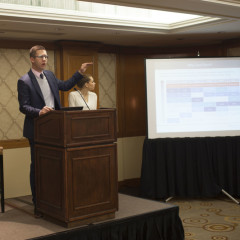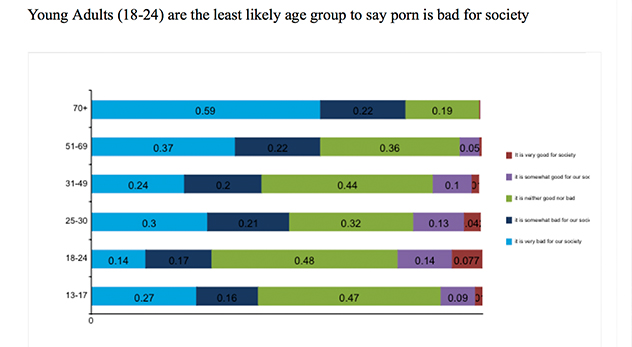
The Barna Group has released a sweeping study of pornography usage and attitudes in America. How concerned should Christians be? -Image courtesy of Luca Rossato (http://bit.ly/1Wvdr77)
Josh McDowell, prominent apologist and author of best-selling books such as The New Evidence That Demands a Verdict, says, “Porn is probably the greatest threat to the church in its existence.” He is so alarmed about pornography’s pervasive influence that he commissioned Barna Group to conduct a sweeping, comprehensive survey on pornography in America.
The results, released yesterday at a press conference in New York City, showed that pornography usage has become less taboo among Americans, has morphed in the digital age, affects both men and women, and is prevalent among Christians and non-Christians alike. [tweetable]The number of Christians viewing pornography virtually mirrors the national average.[/tweetable]
Religion’s critics charge that conservative Christianity has become sex-obsessed, placing a disproportionate amount of influence on topics like abstinence, sexual orientation, and pornography. These judgments are not altogether invalid. [tweetable]Conservative Christians’ responses to the sexual revolution of the 1960s and 70s have often bordered on paranoia.[/tweetable] And yet, the pornography industry undeniably contributes to many social ills, including the objectification of women and the exploitation of children and teenagers.
As a result, the key findings of Barna’s study deserve serious attention:
- The definition of pornography varies somewhat. The question of what should be considered “pronography” is a difficult one to answer, historically. Barna’s editor-in-chief Roxanne Stone notes that, for Americans, it is a matter of both form and function. “The most common definition of pornography among Americans is any image used for sexual arousal or masturbation,” she says. Other Americans believe even a partially nude image should be classified as pornography as well.
-

Barna’s David Kinnaman and Roxanne Stone present “The Porn Phenomenon” study results at the Omni Berkshire hotel in New York City. – Image courtesy of Barna Group
Young Americans do not think pornography is a negative thing. When they speak about pornography with friends, 90 percent of teens (ages 13 to 17) and 96 percent of young adults (ages 18 to 24) say they do so in a neutral, accepting, or encouraging way. Only one in 20 young adults and one in 10 teens say their friends think viewing pornography is a bad thing. [tweetable]Teens and young adults say “not recycling” is more immoral than viewing pornography.[/tweetable]
- Most teens are “sexting.” While you probably think your Jesus-loving child is keeping things kosher when you aren’t looking, you’re likely wrong. Sixty-six percent of teens and young adults have received a sexually explicit image via text and 41 percent have sent one. More girls than boys have sent explicit images, Stone notes, which may mean that young males are often the ones pressuring their female friends to take off their clothes.
- Porn is not just a “male matter” anymore. While men have traditionally consumed pornography at a much higher rate than women, it appears that females (particularly younger ones) are starting to catch up. Thirty-three percent of women ages 13 to 24 seek out porn at least once per month.
- Americans agree that certain types of porn are negative. Overwhelming majorities of Americans across generations believe that porn depicting children under the age of 12 and depictions of non-consensual sex acts are “always wrong.” [tweetable]Fewer than one-quarter of Americans say same-gender pornography is “always wrong.”[/tweetable]
- Fewer pastors struggle with porn than you might expect–or so they say. Fourteen percent of pastors and 21 percent of youth pastors say they currently struggle with porn. If this seems low, it is possible that social desirability bias makes pastors less likely to fess up. As Kinnaman notes, “There’s a ton of guilt, repetitional risk, even the risk of losing their jobs among pastors who view porn.”
- Pastors who struggle with porn feel fear and guilt. Eighty-seven percent of pastors who say they struggle with porn feel “a great sense of shame” and 55 percent “live in constant fear of being discovered” due to viewing pornography.
- Many Christians believe pastors caught viewing porn should be ousted from the church. Forty-one percent of adult Christians think a pastor should be fired or asked to resign if they they are found using porn. Only 8 percent of pastors say the same, favoring solutions such as counseling, accountability, and mentors instead.
- Pastors aren’t convinced porn use is a top problem among their congregants. Thirty-eight percent of pastors call pornography a “major” or “significant” problem in their congregation. A majority of pastors say that spiritual immaturity, lack of biblical knowledge, pride, and lack of church involvement are more serious issues.
If you consider the increasing prominence of pornography in America to be a problem–as many religious people do–these statistics should concern you. But how alarmed should you be? The answer may depend on which type of Christian you are.
For culture-warring conservative Christians, this issue reinforces your belief that America is in some sort of moral decline. Pornography is a single wave in a larger tsunami of social change. Statistics like this seem like further proof that the “traditional values” you hold dear are fading fast. This seems to be the position of the visibly impassioned Josh McDowell at “The Porn Phenomenon” who shouted at one point, “We need a Bonhoeffer or a Wilberforce to stand up to pornography the way they did to Naziism and slavery.”
While I think that the rise of pornography is a troubling in many ways, I have to part ways with those Christians who cross over from concern to paranoia. Pornography simply cannot be compared to the forced enslavement of entire races or the Jewish Holocaust.
The American Church cannot be silent as pornography becomes ever more prevalent. We cannot ignore the way the industry contributes to the notion that women are little more than sex objects to be dominated by men. We cannot ignore how the industry has often preyed on children and exploited teenagers for financial gain. And we cannot ignore the way pornography usage among curious kids has often sexualized them in their most innocent years.
American churches cannot bury their heads, but neither should they lose them.






